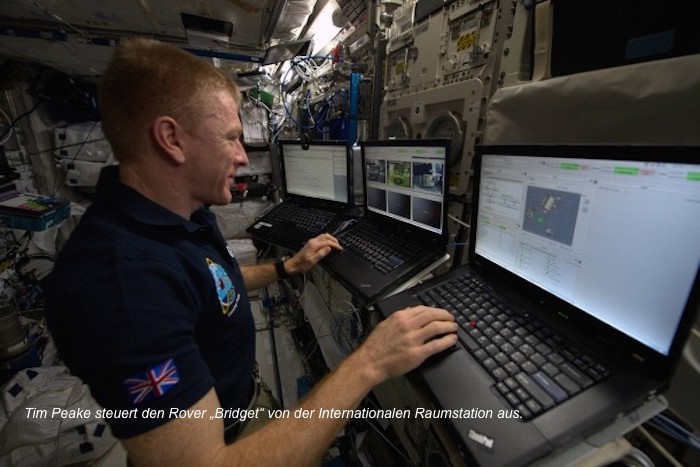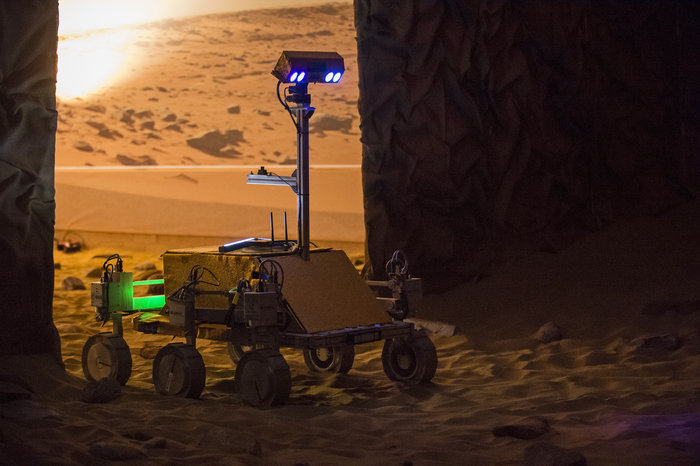.
Weltraumfahrzeuge, die auf dem Mars oder dem Mond herumkurven, gibt es seit längerem. Jetzt wurde ein Roboterauto aus 400 Kilometern Höhe in der Nähe von London per Weltraum-Internet ferngelenkt.
.

Der britische Astronaut Tim Peake hat von der Internationalen Raumstation ISS aus ein Roboterfahrzeug auf der Erde ferngesteuert. Peake lenkte den Rover „Bridget“ zwei Stunden lang durch eine künstlich errichtete Mars-Landschaft in der Nähe von London. „Das war super erfolgreich, wir sind sehr glücklich“, sagte Sebastian Martin von der Europäischen Raumfahrtagentur (Esa) der Deutschen Presse-Agentur. Wissenschaftler des europäischen Satelliten-Kontrollzentrums (Esoc) in Darmstadt überwachten das Experiment. Der ferngesteuerte Roboter, der 300 Kilogramm schwer ist, erreichte eine Höchstgeschwindigkeit von zwei Zentimetern pro Sekunde, allerdings nur in einfachem, flachem Gelände.
Bei dem Test sei es für Peake aber darauf angekommen, „Bridget“ durch schwieriges Gelände zu lenken, sagte Martin. Besonders kompliziert sei das Navigieren in völliger Dunkelheit gewesen. Dazu musste der Rover auf dem Londoner Airbus-Testgelände in eine künstliche Höhle fahren. Dort sei es „Bridget“ gelungen, verschiedene leuchtende Objekte zu identifizieren und ihren Standort auf digitalen Karten zu markieren.
Zur Steuerung wurde laut Esa ein sogenanntes Disruption Tolerant Networking verwendet, „eine Art Weltraum-Internet“, das auch mit schweren Kommunikations-Abbrüchen und großen Latenzen umgehen könne. Das Besondere sei bei dem Experiment gewesen, „dass Peake das Fahrzeug live steuern konnte, praktisch wie mit einem Joystick“, sagte Martin.
.

Dieser Rover fuhr in London auf das Kommando vom Tim Peake
.
Das Ziel solcher Experimente sei es laut Martin, Raumfahrzeuge etwa auf dem Mars, dem Mond oder auf Asteroiden von Astronauten von Orbitern aus zu steuern, die um diese Himmelskörper kreisen. Dadurch würden große Zeitverzögerungen vermieden: Signale von der Erde brauchen zum Beispiel etwa 20 Minuten, um zum Mars zu gelangen.
Quelle: FAZ
-

ESA astronaut Tim Peake today controlled, from the International Space Station, a rover nicknamed Bridget at Airbus Defence and Space in Stevenage as part of an international experiment to prepare for human–robotic missions to the Moon, Mars and beyond.
Building on previous test campaigns in the ESA-led Meteron project, the experiment saw ESA, the UK Space Agency and Airbus Defence and Space working together to investigate distributed control of robots in a mock-Mars environment.
David Parker, Director of Human Spaceflight and Robotic Exploration, said: “This experiment further proves we can operate rovers while orbiting a planet, another significant step in our vision to send astronauts and robots together to explore our Solar System.
“Our investments over the last years in human spaceflight and robotic exploration have showed real results today and prepared the way for our future ambitions to the Moon and beyond.”
The simulated Mars environment, dubbed the Mars Yard, was created by Airbus to develop the locomotion and navigation systems for ESA’s ExoMars rover. The experiment will provide valuable data to assess the benefits of human involvement in a rover’s path planning.
The experiment also involved teams at ESA’s ESOC operations centre in Germany, which served as the mission control centre for the experiment, and Belgium’s Station User Support and Operation Centre in Brussels, serving as the interface to the Station.
As future exploration of the Solar System is both a human and robotic endeavour, the purpose of Meteron is to prepare for missions that are likely to involve astronauts orbiting the planet and controlling or supervising rovers on its surface.
The advantage of this method is that it will cut out the time delay due to distance experienced when controlling rovers from Earth and allow more direct intervention from humans when needed, such as navigating around hazards or identifying targets.
Human exploration is a relatively new yet expanding area for the UK, where there is a strong heritage in robotics and autonomous systems – important technologies to the country’s international competiveness, productivity and economic growth across a broad range of industrial sectors.
The international ExoMars mission is a great example of success in robotics, with the UK being the second-largest contributor to the mission through ESA. This contribution has secured the future of the high-impact space programme and given the UK the overall leadership of the rover module whose complete design, including the final integration and testing, will be done in the UK.
Quelle: ESA
4110 Views
